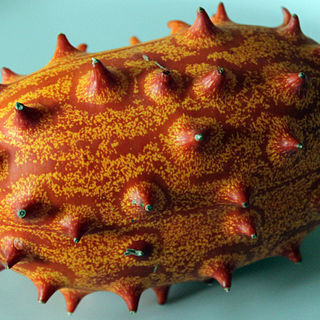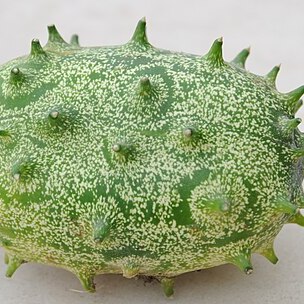A pumpkin family plant. It is an annual plant. It grows to 0.5 m tall and spreads to 1.5 m wide. The stems are trailing and hairy. The tendrils are curled and do not branch. The leaves have 3 lobes and are heart shaped. The edges of the leaves have teeth. The flowers are funnel shaped. and yellow. They open into five lobes. Male and female flowers occur on the same plant. The female flower is above a prickly green ovary which enlarges to become the fruit. The fruit are oblong and spiny and change from green to orange as they ripen. They are 12 cm long and 6 cm across. The fleshy pulp surrounding the seeds is bright green. The seeds are white. It tastes and smells like a cucumber. The skin is not eaten.
Plants: rootstock woody. Tendrils glabrate to hispid. Leaves: petiole setose; blade ovate, 3-lobate or weakly palmately 3–5-lobed, (4–)6–12(–14) × (3.5–)5.5–10(–12) cm, length 1.2–1.4 times width, base cordate, lobes elliptic to ovate, margins serrate. Inflorescences: pedicels of pistillate flowers and fruits cylindric; staminate flowers usually 2–5 in fascicles, rarely solitary; pistillate flowers: calyx lobes 2–3 mm, petals 6–10(–17) mm, corolla tube 1–1.6 mm, lobes sparsely puberulent inside. Pepos yellow to yellow-orange, monocolor, cylindric-ellipsoid, 0.6–1.5 × 3–6 cm, surface muricate to aculeate at maturity, spinules thick-based, glabrous, flesh lime green, <jellylike>. 2n = 24.
Prostrate or scandent annual herb. Tendrils solitary at each node. Fruit bright red when ripe; rather sparsely covered with stout fleshy spines. Seeds fibrillose. Flowers yellow or pale orange; January to April.
Fruit pendulous, scarlet when ripe, with stout spines.
Foliage like that of the cucumber
A yellow-flowered annual climber


